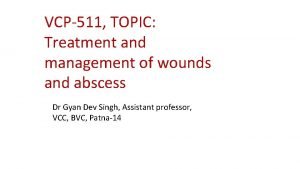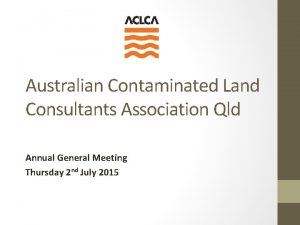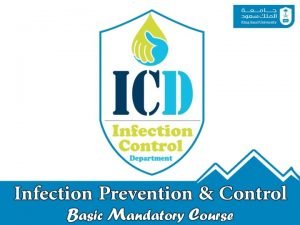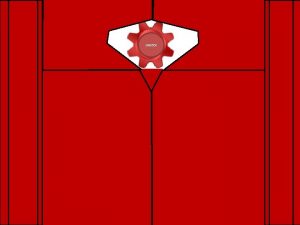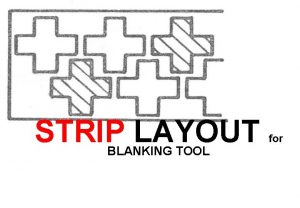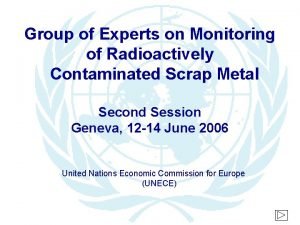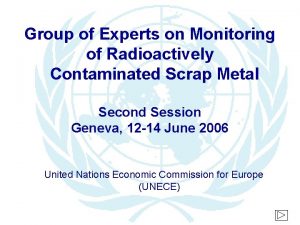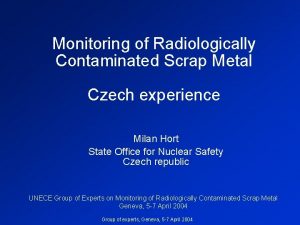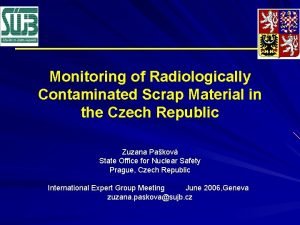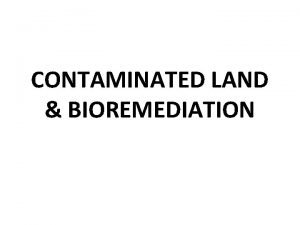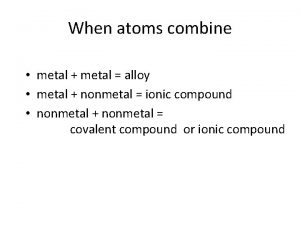System of control of radioactively contaminated metal scrap









- Slides: 9

System of control of radioactively contaminated metal scrap in Lithuania Gendrutis Morkūnas Radiation Protection Centre Kalvarijų 153, LT-08221, Vilnius, Lithuania genmo@takas. lt

General situation • all the practices except for irradiation available • radioactive sources are imported and spent sources exported • radiation protection infrastructure in place: – notification about intentions to import, export and transport radioactive sources, – licensing of practices, – keeping of national register of sources, – ensuring of physical security of sources, – use of safe procedures during their transportation, – treatment of radioactive waste and spent sources

Legislation • control of movement of metal scrap • detection of radioactivity in metal scrap • detection of radioactivity on the national borders • dealing with found radioactive sources, • radiation protection • other related legislation

Technical measures • monitoring of metal scrap in scrap yards, metal scrap and final products in reprocessing plants • monitoring of radioactivity on the borders • procedures when radioactive sources are detected • more detailed analysis with the aim of characterization of sources in Lithuania and abroad • training of involved staff

Items already detected • contaminated metal • materials containing increased concentrations of natural radionuclides • sources, previously used in practices • commodities containing increased amounts of radionuclides • contaminated vehicles have been found Patients released after nuclear medicine procedures are triggering monitoring systems

Training • target groups are identified • training shall address specific needs of these groups • more attention should be given to selection of trainees • training should help to optimize the whole system • international training courses (due to co-operation) might be useful

International cooperation • for information exchange • international training courses or national ones with lecturers from other countries • existing networks of exchange of information (e. g. , CEEAN) might be used • common efforts in more detailed characterization of found materials

Observations and conclusions • the system should include both general and specific measures • training should address different categories of persons involved • training should help to optimize the system • it has to be of international character

Observations and conclusions • monitoring equipment which meets the needs and complies with competence of users should be further developed • attention should be paid to quality assurance and particularly elaboration and validation of monitoring techniques • international cooperation is important • available resources should be effectively used
 Contaminated wound
Contaminated wound To inform the readers/listeners about a newsworthy event.
To inform the readers/listeners about a newsworthy event. Australian contaminated land consultants association
Australian contaminated land consultants association Waste mangment
Waste mangment Contaminated product insurance
Contaminated product insurance Pengertian routing sheet
Pengertian routing sheet Bbc bitesize electric bell
Bbc bitesize electric bell Certified scrap lead acid batteries recycler
Certified scrap lead acid batteries recycler Strip layout types
Strip layout types Lesson outline magnets and magnetic fields answer key
Lesson outline magnets and magnetic fields answer key
